Edward Burtynsky is a Canadian photographer whose work documents the impact of industry on the environment. Most of his work is quite large, high resolution prints taken with a large-format camera that capture bleak but visually rich vistas of industrial wastelands – sometimes the aftereffects, sometimes ongoing industrial sites. He’s quite celebrated – he has received the Order of Canada among other awards and was the subject of an award-winning feature-length documentary, Manufactured Landscapes (2006). I saw a selection of his work in 2004 at the Musée d’art Contemporain in Montreal, and was quite simply awestruck.
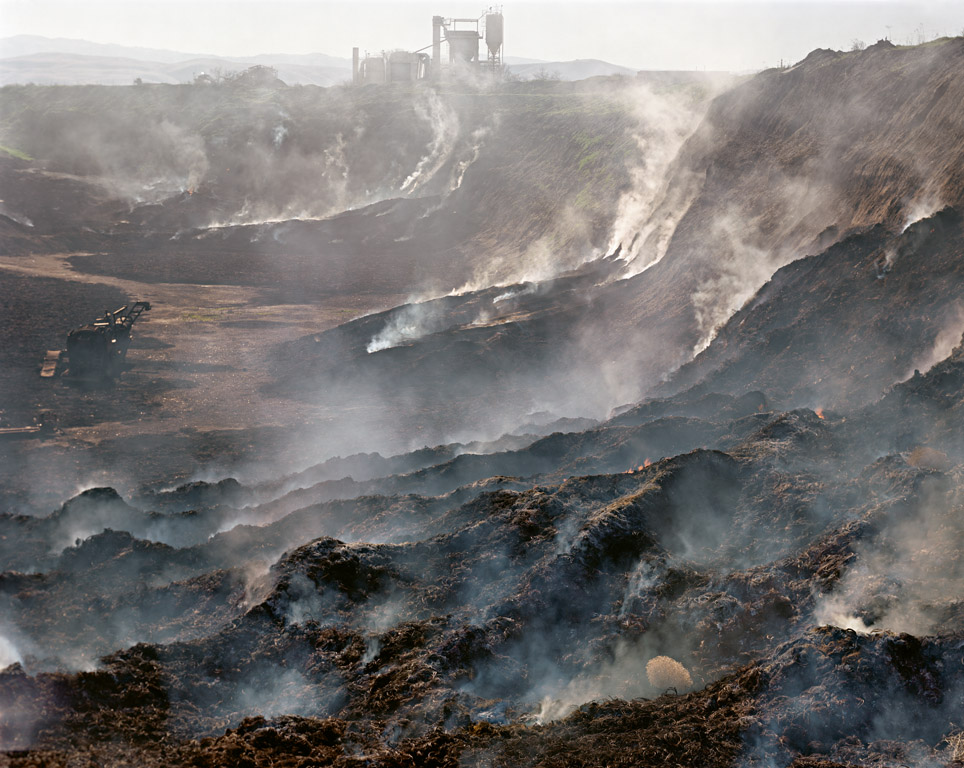
Burning Tire Pile # 1
Near Stockton, California 1999
The beauty of his works is the first thing that strikes you as you meander through the galleries. He works in medium-to-large formats: 30″ x 40″ or 40″ x 50″ prints that sit proud on a wall. They are powerful in a way akin to the early natural landscapes of Carleton Watkins or Eadweard Muybridge, who in the mid- to late-19th century strove to honour the majesty of nature through their photographs, choosing viewpoints that purposefully dwarfed man under the immensity of rolling mountains and the like in the forefront. Burtynsky’s scenes are similarly awing for the sheer size of the objects or locations he photographs; his images of comparatively diminutive trains cutting across vertiginous, humongous precipices in Ontario or of miniature workers taking apart giant defunct ships in Bangladesh demonstrate the smallness of the human race.
One main and essential difference, though, is that the very subject of these works is the fact that man has seized power over these places. None of the locations he chooses as subjects are so-called pure, unadulterated nature; they are all areas particularly dominated by people purposefully striving toward economic gain. The striking vibrancy of the fluorescent orange nickel streams left over by a mine in Sudbury, Ontario, exist as photographed because they were extracted and left there by man. The mesmerizing geometric patterns made by the striations in the earth’s marble shield in Italy exist because man has cut through it that way to sell it in portions. The giant tire mountains of California, or the crushed metal compounds, exist because of what man has made, used and disposed of from the oil he’s sucked out of the earth or the metal he’s pillaged from its soil.
– Isa Tousignant, Hour Community 2004
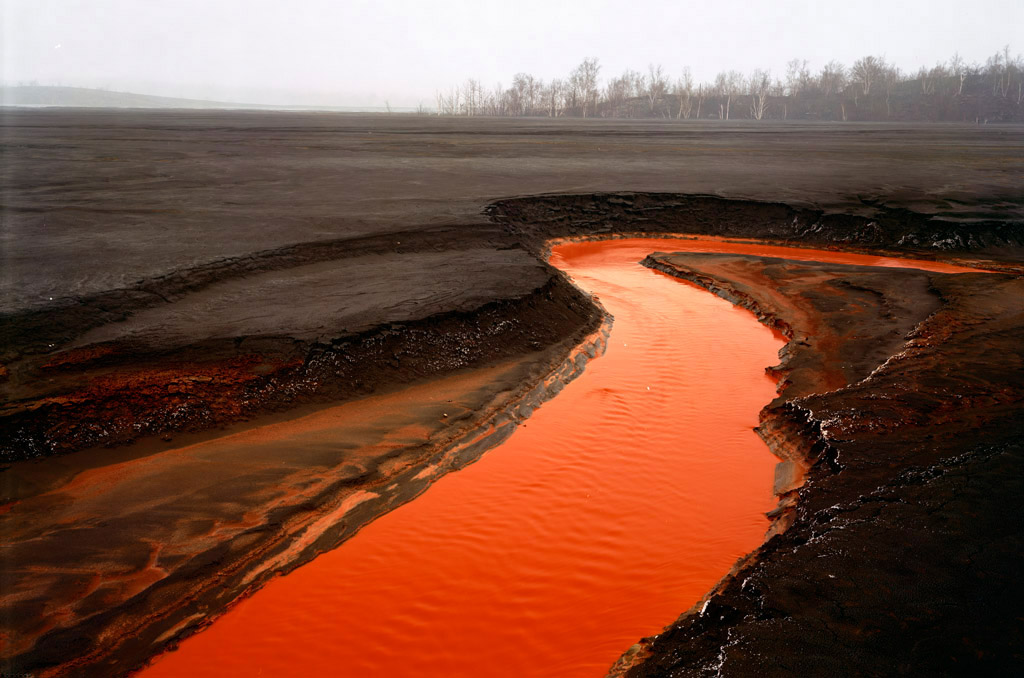
Sudbury Nickel Tailings no. 34
I think the pieces that struck me the most were the tailings of a nickel mine in Sudbury. These pieces are so unlike what we expect to see on this planet that they almost read as abstract colour fields.
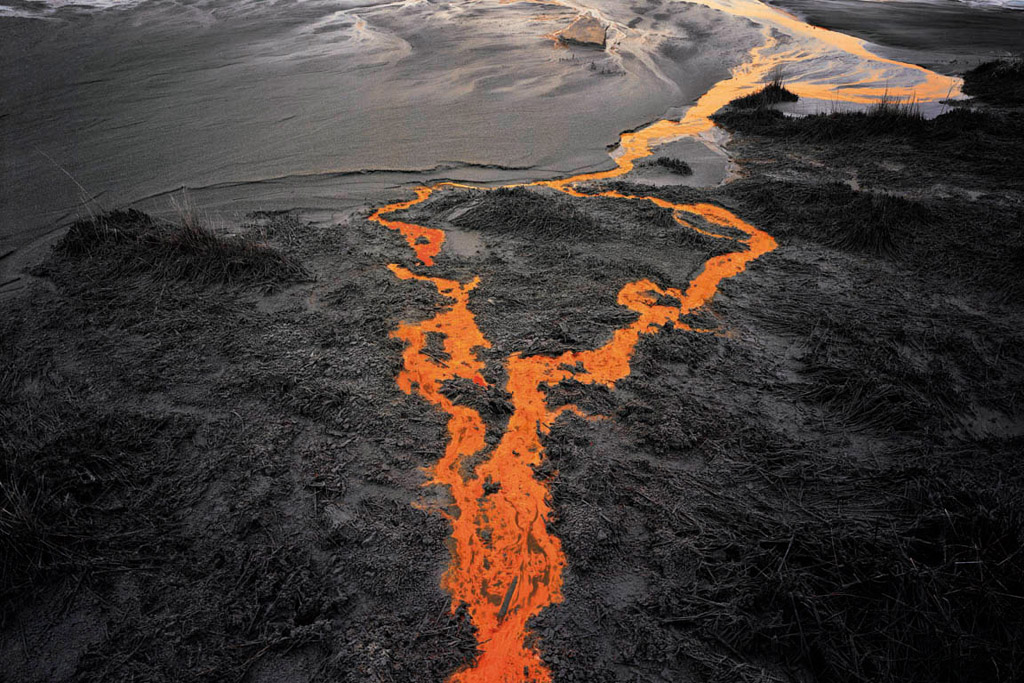
Sudbury Nickel Tailings no.31
The stark contrast of the swaths of reddish orange in that black deathscape are only plausible because you know these are photographs. This not to downplay the impact of more recognizable scenes like the tire dumps, abandoned quarries, or salvage yards – if anything, they serve to heighten the horror of these scenes of devastation that most of us sort of realize are going on all the time all over the world but we carefully file away with other unpleasant realities.

Rock of Ages # 4,
Abandoned Section, Adam-Pirie Quarry, Barre, Vermont, 1991
A quite extensive selection of Burtynsky’s work including photographs of salvage yards, oil spills, dumps, tailings, quarries, and much more can be seen on his site. If you are even fleetingly concerned about humanity’s impact upon the natural environment you really must make the time and take a look. Whether Burtynsky’s ouevre is a cautionary tale for future generations or a document of our planet’s destruction remains to be seen.
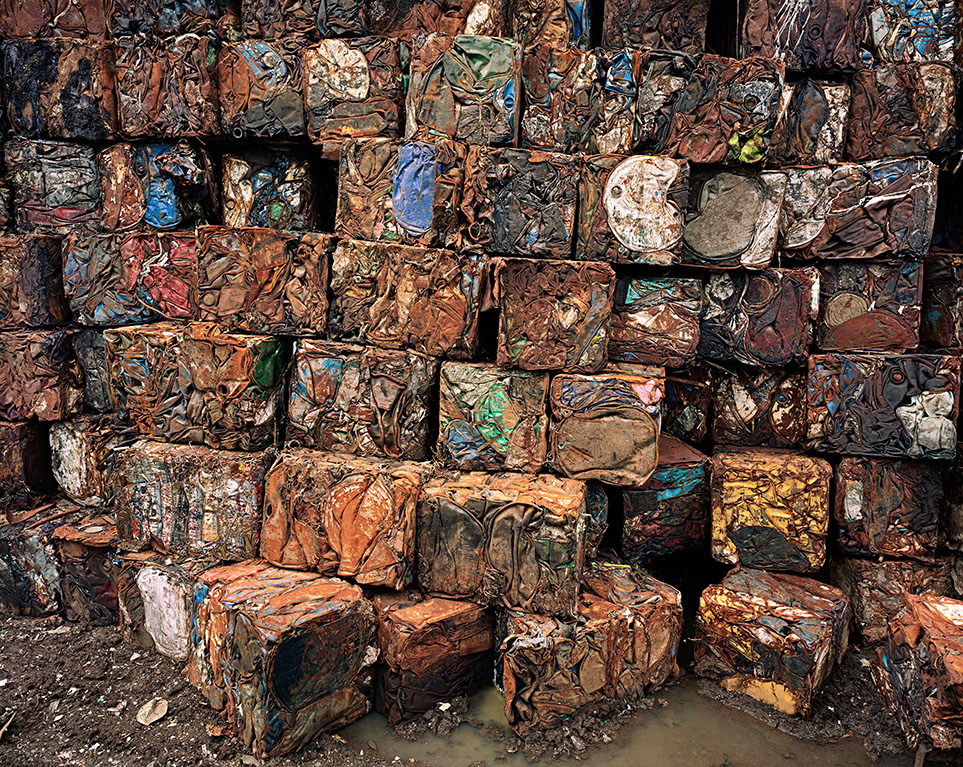
Densified Oil Drums No. 4,
Hamilton, Ontario 1997
Nature transformed through industry is a predominant theme in my work. I set course to intersect with a contemporary view of the great ages of man; from stone, to minerals, oil, transportation, silicon, and so on. To make these ideas visible I search for subjects that are rich in detail and scale yet open in their meaning. Recycling yards, mine tailings, quarries and refineries are all places that are outside of our normal experience, yet we partake of their output on a daily basis.
These images are meant as metaphors to the dilemma of our modern existence; they search for a dialogue between attraction and repulsion, seduction and fear. We are drawn by desire – a chance at good living, yet we are consciously or unconsciously aware that the world is suffering for our success. Our dependence on nature to provide the materials for our consumption and our concern for the health of our planet sets us into an uneasy contradiction. For me, these images function as reflecting pools of our times.
– Edward Burtynsky, Artist’s Statement
Another collective noun – today, a Shrewdness of Apes.
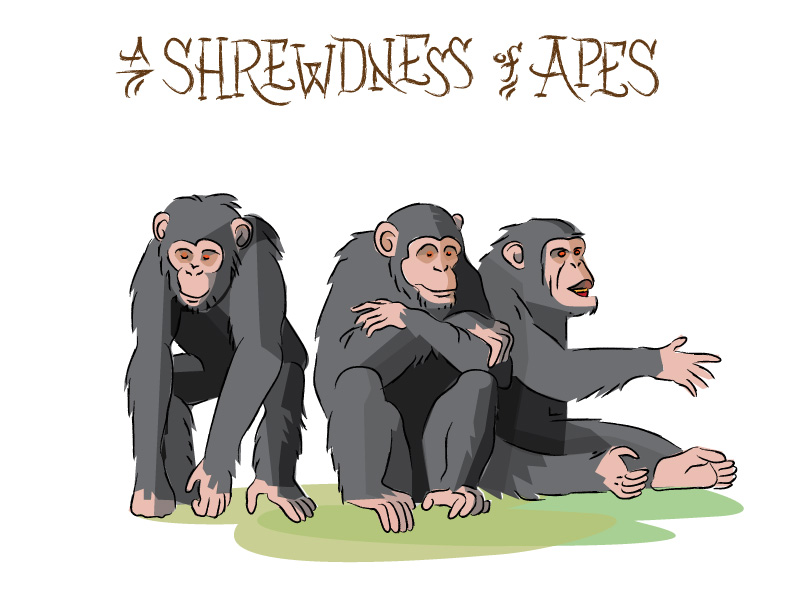
I admit, I found “shrewdness” to be an odd choice for a collective of apes. Through the magic of the interwebs, however, I found this thorough and enlightening explanation:
…let me give an example of how a noun is related to the collective through the fascinating case of a “shrewdness of apes.” On first blush we might think that this is a kind of joke also, because apes are not often thought of as shrewd. When we call someone an “ape,” we mean anything but the fact that the person shows shrewdness. As we scratch beneath the surface of this term, however, a whole new world opens. The OED has a reference to a “shrewdness of apes” in John Eliot Hodgkin’s Proper Terms (1909). This important work, which I will describe in more detail in the next essay, collated medieval manuscripts of various lists of collective nouns. Two of the more important medieval collections he put together were from what was known as “Termys of venery” (the so-called Egerton MS 1995) and the 1486 Boke of St. Albans. These 15th century manuscripts had the following: (1) “A Schrewdenys of Apys” (Egerton) and (2) “A Shrewnenes of Apis” (St. Albans). Thus this term was attested in the late 15th century. But why a “shrewdness”?
The answer becomes clear when we understand the history of the use of “shrewdness” in English. The meaning of shrewdness as “sagacity or keeness of mental perception” only goes back to Shakespeare’s Antony & Cleopatra 2.2: “So much uncurbable, her garboils, Caesar/ Made out of her impatience, which not wanted/ Shrewdness of policy too…” But three centuries before the Bard the only meaning of shrewdness was “wickedness, depravity; evil disposition, ill nature; malignity; maliciousness.” In fact, its first usage was in connection with Lucifer, the Fallen Angel. With this cluster of concepts surrounding the first appeareance of shrewdness in our language, we can more readily understand how a “shrewdness of apes” would have appeared. As a matter of fact, now that we know what I have just described, it gives us new “glasses” to study how apes might have been perceived by people in the Middle Ages…
– William R. Long, via drbilllong.com
From what I recall, apes were actually a symbol of the Devil (or the Devil’s influence on Man) in medieval art, essentially representing the baser instincts of Man manifested through various states of sinfulness.
I was recently contacted by Mathieu St-Pierre, a glitch artist from Montreal that now lives & works in South Korea. “But wait”, you say, “What is this glitch art you speak of?” Ah, glitch art. Such a fascinating manifestation of our digital age. A byproduct of our collective technolust for ever-better digital reproduction, the lossy, corrupted or simply defective output that our devices barf back at us are oddly compelling.
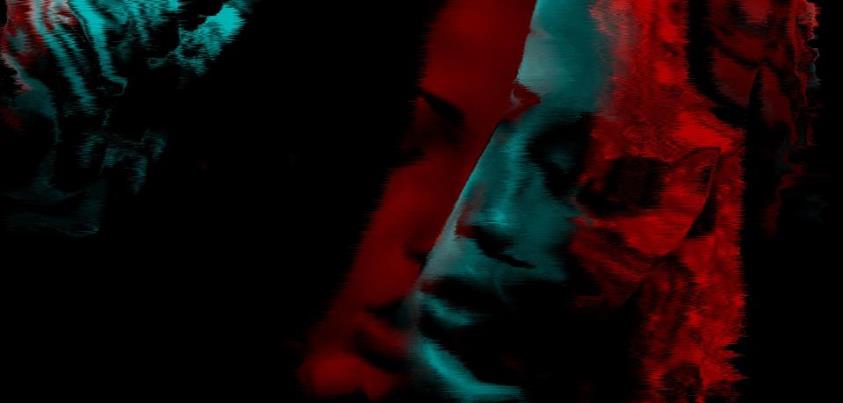
In a technical sense a glitch is the unexpected result of a malfunction. The term is thought to derive from the German glitschig, meaning “slippery”. It was first recorded in English in 1962 during the American space program by John Glenn when describing problems they were having, Glenn explained, “Literally, a glitch is a spike or change in voltage in an electrical current.”
Glitch is used to describe these kinds of bugs as they occur in software, video games, images, videos, audio, and other forms of data. The term glitch came to be associated with music in the mid 90s to describe a genre of experimental/noise/electronica (see glitch music). Shortly after, as VJs and other visual artist like Tony (Ant) Scott began to embrace the glitch as an aesthetic of the digital age, glitch art came to refer to a whole assembly of visual arts.
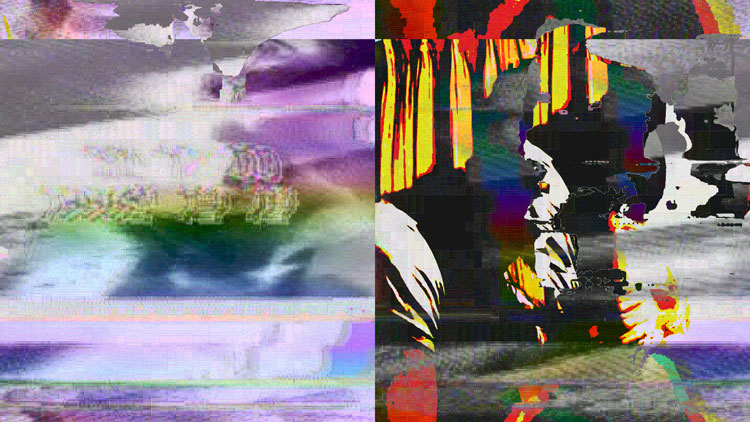
Mathieu St-Pierre’s main body of work is intentionally corrupted video stills, an influence from his background in film. His artist’s statement gives a pretty clear idea of his intentions, so let’s cut right to the chase here:
Mathieu St-Pierre is a Canadian artist who focuses on visual artifacts
created by various computer programs and from the more traditional
analog video signals. The consequence of those imperfections and
corrupted files are his landscapes and narrative images (stills).
Also, having a film background helps him to compose with emerging
medias and explore new possibilities of the digital canvas.
The images not only document the fragility of those virtual data, they
are often capable of triggering memories and associations from real
world life experience. We are consequently faced with electronic
malfunctions in the realm of pixels versus the perfect imagery.
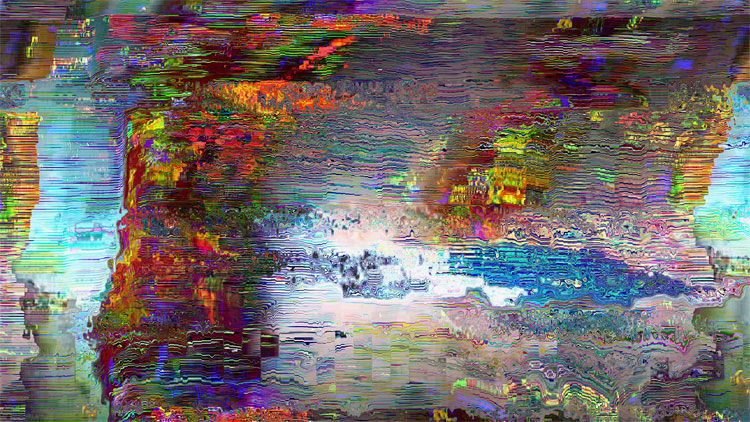
I guess the question with glitch art is whether the glitch is a manifestation of the “real”, i.e.; the natural world infiltrating the technological world. Is the glitch more authentic than the intended image, or less? Outside intention, which is signal, which is noise? It’s fascinating how a few misplaced characters here and there transform a video still into a visual cacaphony.

More of Mathieu St-Pierre’s work can be seen on his website or via his Book of Faces page.
Another collective noun – today, a Rake of Colts. In looking up information regarding this collective noun, I found out that colts are specifically uncastrated male horses under four years old.
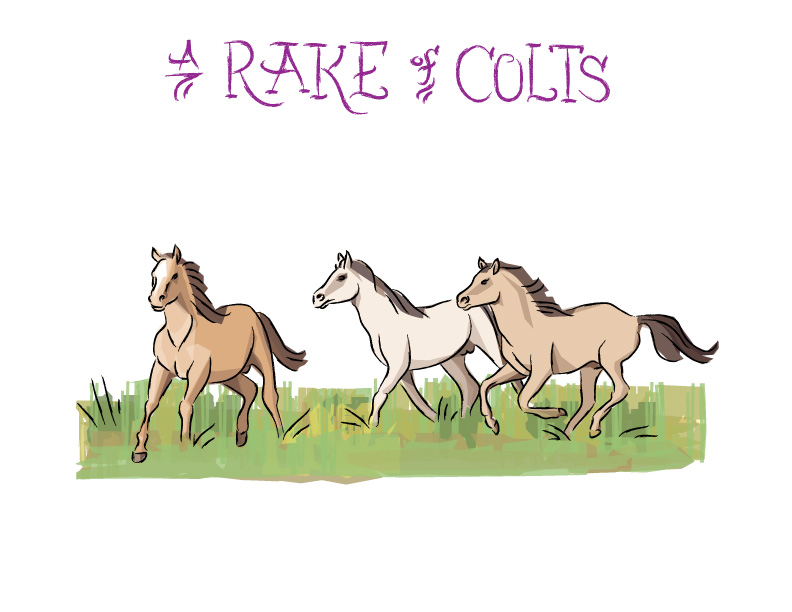
I’ve never heard the term “rake” applied to colts, but apparently it’s a legitimate (albeit archaic) usage.
Rake: colts or mules, collectively; a row or series.
Examples: rake of colts—Bk. of St. Albans, 1486; rake of hutches (a string of horses), 1901.
– “Rake.” Dictionary of Collective Nouns and Group Terms. Ivan G. Sparkes, 1975.
Another collective noun – today, a Quarrel of Sparrows. Today, I learned that I really should try to forget everything I thought I knew about birds. When I was a kid, my dad would point out the names of all the birds we saw. For years, I thought that male starlings were grackles. Today, I learned that what I thought were chickadees are, in fact, male sparrows. Thanks, Dad.
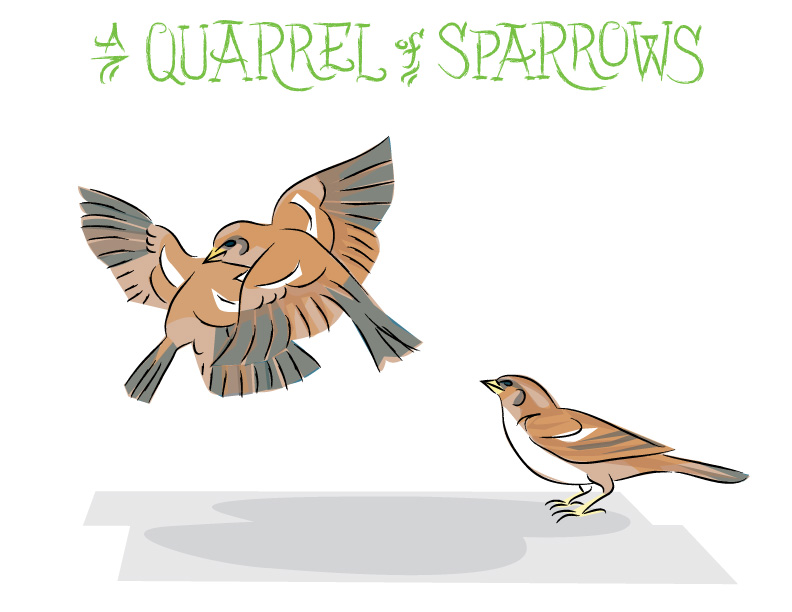
It is pretty funny watching wee little sparrows knocking the living heck out of each other; they really tussle. For all their tininess, they take their fighting very seriously and go at it all the time. A “quarrel” is a pretty appropriate group name, I think.


